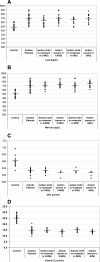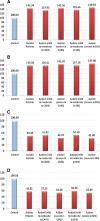A key role for an impaired detoxification mechanism in the etiology and severity of autism spectrum disorders
- PMID: 24776096
- PMCID: PMC4017810
- DOI: 10.1186/1744-9081-10-14
A key role for an impaired detoxification mechanism in the etiology and severity of autism spectrum disorders
Abstract
Background: Autism Spectrum Disorders (ASD) is a syndrome with a number of etiologies and different mechanisms that lead to abnormal development. The identification of autism biomarkers in patients with different degrees of clinical presentation (i.e., mild, moderate and severe) will give greater insight into the pathogenesis of this disease and will enable effective early diagnostic strategies and treatments for this disorder.
Methods: In this study, the concentration of two toxic heavy metals, lead (Pb) and mercury (Hg), were measured in red blood cells, while glutathione-s-transferase (GST) and vitamin E, as enzymatic and non-enzymatic antioxidants, respectively, were measured in the plasma of subgroups of autistic patients with different Social Responsiveness Scale (SRS) and Childhood Autism Rating Scale (CARS) scores. The results were compared to age- and gender-matched healthy controls.
Results: The obtained data showed that the patients with autism spectrum disorder had significantly higher Pb and Hg levels and lower GST activity and vitamin E concentrations compared with the controls. The levels of heavy metals (Hg and Pb), GST and vitamin E were correlated with the severity of the social and cognitive impairment measures (SRS and CARS). Receiver Operating Characteristics (ROC) analysis and predictiveness curves indicated that the four parameters show satisfactory sensitivity, very high specificity and excellent predictiveness. Multiple regression analyses confirmed that higher levels of Hg and Pb, together with lower levels of GST and vitamin E, can be used to predict social and cognitive impairment in patients with autism spectrum disorders.
Conclusion: This study confirms earlier studies that implicate toxic metal accumulation as a consequence of impaired detoxification in autism and provides insight into the etiological mechanism of autism.
Figures




References
-
- American Psychiatric Association. Diagnostic and Statistical Manual of Mental Disorders (fourth, text revision ed.) Washington, DC: American Psychiatric Association; 2000.
-
- El-Ansary A. Detoxification mechanisms in autism spectrum disorders. OA Autism. 2013;10(2):19.
-
- Koch L. Cancer: polymorphisms in detoxification genes increase in HMTC and match tumor phenotype. Nat Rev Endocrinol. 2013;10:128. - PubMed
-
- McFadden SA. Phenotypic variation in xenobiotic metabolism and adverse environmental response: focus on sulfur-dependent detoxification pathways. Toxicology. 1996;10(1–3):43–65. - PubMed
Publication types
MeSH terms
Substances
LinkOut - more resources
Full Text Sources
Other Literature Sources
Medical
Research Materials

